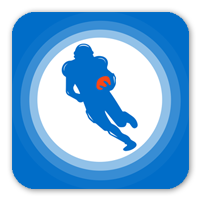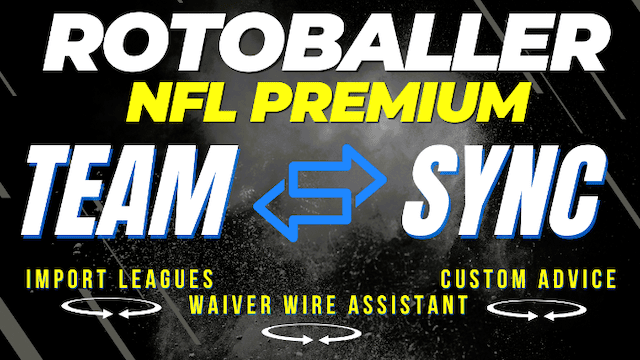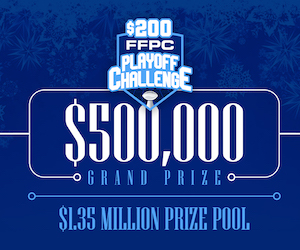One of the most commonly used pieces of jargon in fantasy football analysis is roster construction. It is almost always used at the tail-end of a debate to reconcile two seemingly irreconcilable positions. Usually something along the lines of, “Well, I guess this really comes down to roster construction and how you want to build your team.” Too frequently the conversation ends there with no further discussion of just how roster construction plans would affect the pros or cons of any idea.
So just what is a fantasy football newcomer to make of an idea that is dependent on roster construction, something that is so rarely defined? This guide is designed to explain exactly what roster construction is and how you should think about building your team.
Roster construction is essentially a way to address the various trade-offs that come with each decision that you make when building your team. Some trade-offs are obvious. If you select Todd Gurley with the first overall pick, then you likely are not going to be able to also select Le’Veon Bell. However, some of these trade-offs can be a bit more abstract. This guide will review some of the biggest trade-offs and decisions that a fantasy owner would have to make in their draft. The aim isn’t to provide a single, fool-proof strategy guaranteed to win your league. Rather, it is just an attempt to give you a logical framework to make decisions over the course of your draft.
Editor's Note: The FFPC Playoff Challenge is back with a massive $500,000 grand prize and $1.35 million total prize pool, paying down to 800th place. Here's the deal: no salary cap, no draft, no pickups, no subs. Choose 10 players, and as NFL teams get knocked out so will your players, so choose your team wisely. The 7,250 entries will sell out quickly, and registrations will close on Saturday January 10th at 4:30 pm ET . Don't wait - get your team now and end your fantasy football season with a shot at $500,000! Sign Up Now!
Roster Constuction Overview
First, some basics. While roster construction and fantasy football are games of trade-offs, there a couple of concrete facts that lay the foundation of how to build a team.
Chief amongst those facts is the differences between positions. While there are many ways to evaluate individual players across positions, it is important to understand the different how the positions themselves behave. Namely, that we as a fantasy football community are much better at predicting the future performances of quarterbacks and tight ends than we are at predicting the future performances of running backs and wide receivers. This isn’t to say that anyone is particularly great at predicting quarterbacks, just that they are relatively better at it than with running backs. Another important fact: an elite running back or wide receiver is almost always more valuable than an elite quarterback or tight end. So in general, you are going to want to roster as many running backs and wide receivers as you possibly can. Both because you can’t be confident that any one of them will be great but also because it is very important to have one or hopefully more studs at those positions.
Another piece of the foundation is that you are limited by how many players on your team can start in a given week. There are many reasons why it may be the right decision to acquire a player who may not start for you. However, at some point you need to convert your assets into points.
Finally, you need to understand variability. Imagine two teams. The first team scores 95 points every single week. The second team scores 115 points every other week and 75 points in the rest. After 10 weeks, both teams would have scored the same number of points but the nature of that scoring is clearly different. The team that is consistent and scores 95 points week-in and week-out has low variability while the team that goes back and forth between 115 and 75 has high variability. There are times when you will want your team to be highly variable and times when you want to have lower variability. Regardless, you should always be aware of just how consistent your team is (or isn't).
So with all of that, let’s start talking about some the key decisions that you will have to make.
What To Do About Quarterbacks?
Keeping in mind that the biggest priority for a fantasy owner is finding stud running backs and wide receivers, how should you handle quarterbacks? Currently one of the biggest trends in fantasy is Late-Round Quarterback. This strategy suggests passing on most of the higher ranked quarterbacks earlier, then streaming, or rotating between, multiple quarterbacks depending on which defense they are playing against each week. By taking advantage of the matchups, a fantasy owner can essentially construct a composite quarterback who plays like one of the better signal callers in the league. The benefit here is that rather than using a higher pick on a quarterback, you can use it on a higher quality running back or wide receiver with more upside.
There are some drawbacks to this strategy. In order to be able to find a quarterback with a good matchup every week, you will likely need to take at least two quarterbacks in the draft. While there isn’t much opportunity cost in using a late round pick on a quarterback, that is still one less running back you will be able to roster. And once the season gets started, you will have to place a priority on quarterbacks during the waiver process.
Alternatively, you can select a quarterback earlier. If you were to pick Aaron Rodgers (not in the first two rounds) you can be relatively confident that he will provide strong production every single week. This means that you wouldn’t have to select any more quarterbacks. This frees up another roster spot for a running back or receiver. It also allows you to more aggressively pursue players at those positions on waivers. Remember that quantity is important at the running back position.
So in a way, how you handle quarterbacks really depends on how you want to pursue running backs. Do you want a single, highly-touted prospect or do you want to take a chance on multiple lower valued players? If it is the former, you should be taking a single quarterback in the draft preferably on the earlier end. If you want to pursue the latter option, you should wait until the end of the draft and take two or more quarterbacks.
The same view can be applied to tight ends. There are a couple of important considerations. First, tight ends tend to produce even less value than quarterbacks so you should wait on them even longer. Secondly, tight ends are a little bit less predictable than quarterbacks, so you may want to stay away from more aggressive strategies that could leave you exposed.
Starting Lineup vs Depth
This tradeoff is more relevant to leagues that utilize an auction draft rather than a snake draft. However, over the course of a season every team will interact with the problem. Should you frontload your roster, have stars across the various starting roles, but have no quality back-ups? This is sometimes called the “stars-and-scrubs” approach. Or should you pursue fewer stars and try and build value throughout your roster?
The benefit of frontloading your roster should be obvious. You need the most amount of points in your starting line-up as possible to win. So, building your team in a way that gets most of its scoring output in the starting lineup will lead to more wins. The downside to this is that your team is going to be more vulnerable to injuries and busts than if you had invested more resources on your bench. Everyone has a different tolerance for risk, so you should be calibrating your roster to your own preferences.
There are some important things to keep in mind when deciding upon your approach. First, if you are going stars-and-scrubs you may want to avoid riskier players. While Odell Beckham has tremendous upside, we do not know exactly how well he will return from injury. While there would be no hesitancy on my part to select him if my team’s value was going to be evenly distributed, I would second-guess the choice if my team was already risky just based on how it was built. Another thing to keep in mind is that you can compensate for a lack of depth by aggressively playing the waiver wire. If you like to play the waiver wire, you should maybe be inclined to go with a stars-and-scrubs approach. However, if you generally avoid that resource, spending more on your bench may be necessary.
Distribution of High Ceiling vs High Floor Players
In fantasy football parlance, a player’s ceiling represents the absolute best possible production from a player, whereas their floor is the worst-case scenario. Ideally, your starting lineup will be filled with players who have both a high floor and a high ceiling. Meaning that you can be confident that the player will still do well in their worst games, but has the potential to dominate when they play well. When it comes to bench spots there is generally a trade-off.
You will be forced to decide upon players who have a lot of upside but at the current moment may not be able to be relied upon consistently (high-ceiling, low-floor) or a player that produces consistently but is likely to never have a dominant game (low-ceiling, high-floor). The high-upside players are what is going to help you win your league in the long run. They can break out and give a big boost to your starting lineup. A good example of this is Alvin Kamara last year. His situation prevented him from producing right away, but with Adrian Peterson’s departure, Kamara was able to reach his potential. You should also keep in mind the many players who do not pan out like Kamara. Last year, for instance, Derrick Henry had a lot of potential if he were to take over primary ball-carrying responsibilities for the Tennessee Titans. However, Henry never became a player you could trust enough to feel good about starting.
Loading up your roster with high-upside guys has some clear benefits. It improves the overall ceiling of your team. It also increases your odds of finding long-term solutions to holes in your roster. However, if you have too many your roster can become vulnerable to injuries in the short-term. If a key starter on your roster is injured, you need a player that you know will deliver points for you the following week. If your bench is filled with prospects and the waiver wire is empty, you may be left with no options. In this scenario, you would prefer to have a reliable player at that position. So, the more high-upside guys you have the more fragile your roster but the higher your team’s ceiling. The more reliable, but low-upside players on your roster the more resilient it will be to injuries but the worse off it will be in the long term.
Generally, you won’t need more than one low-ceiling/high-floor player at a position in case of injury. You will also need to consider how many of each type of player to have at each position. If you picked bunch of wide receivers at the top of the draft and feel more confident in that position, you may want to load up on more high-upside running backs later in the draft. If you went running backs early then vice versa.
Stacking
Stacking is the concept of putting multiple players on the same NFL team into your lineup. Our own Brett Mitchell recently broke down how to do a Deep Stack, if you're into that sort of thing. If you are deciding between two wide receivers who you view relatively equally, but you already have the quarterback of one those receivers on your team, then you should be aware how that changes the equation. Assuming that the two receivers are equivalent, you will not score more over the long-term with either one over the other. However, your scoring will be more variable if you select the wide receiver whose quarterback is on your team. This is because if that quarterback does well, the wide receiver is more likely to have a big game. If the quarterback does poorly, the opposite is true. So you are tying the performance of two players with each other. In general, if you are trying to mount an upset, you should try and be more variable. If you are the favorite in a game you want to limit variability. These are the types of decisions that should be made during the season and shouldn’t have much of an effect during the draft. So the things to remember are that a quarterback-wide receiver stack will increase variability and a quarterback-running back stack will decrease variability. This isn’t true in all circumstances, but the rule generally holds.
Conclusion
With all of this knowledge, you should have a good framework in which to start planning for your draft and the season as a whole. It is these types of trade-offs that make fantasy football challenging, but if you are able to embrace them will also lead to more winning and more fun.





 RADIO
RADIO
























